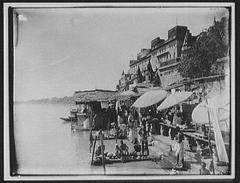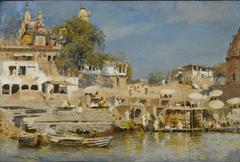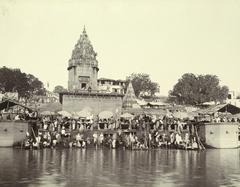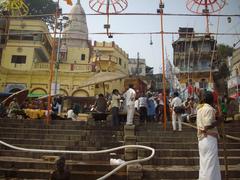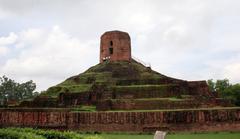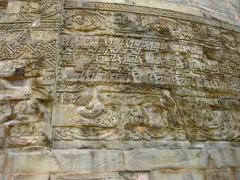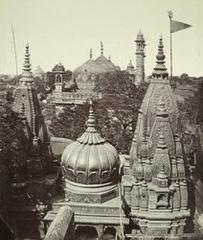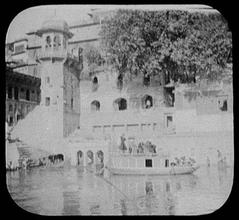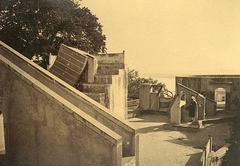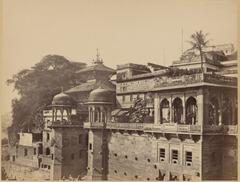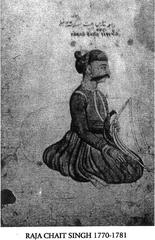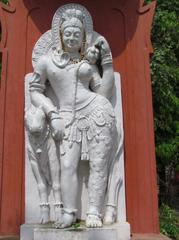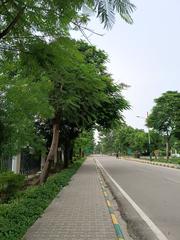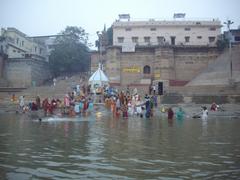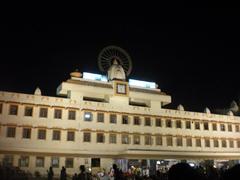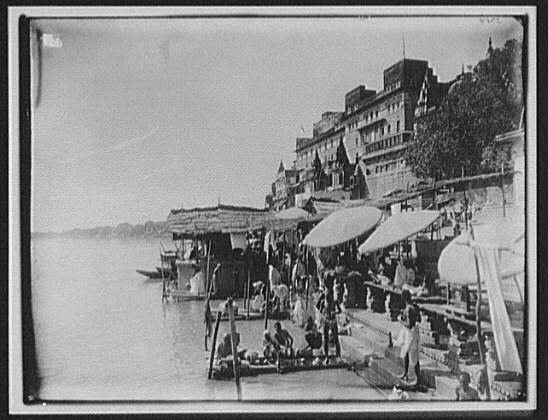
Dashashwamedh Ghat: Visiting Hours, Tickets, and Historical Significance in Varanasi
Date: 14/06/2025
Introduction
Dashashwamedh Ghat, perched on the banks of the sacred Ganges River in Varanasi, India, stands as a revered spiritual, historical, and cultural landmark. Recognized as one of Varanasi’s oldest and most celebrated riverfronts, the ghat is deeply embedded in Hindu mythology and tradition. Its name, derived from Sanskrit—“Dasha” (ten) and “Ashwamedh” (horse sacrifice)—is linked to the legend of Lord Brahma performing ten horse sacrifices to welcome Lord Shiva to earth, infusing the site with profound sanctity (Apnayatra, Revelation Holidays).
Over centuries, Dashashwamedh Ghat has received patronage from influential rulers, notably Maratha king Baji Rao I and Queen Ahilyabai Holkar, whose renovations in the 18th century elevated the ghat’s architectural and religious stature (Citybit, Wikipedia). Today, it is famed for the nightly Ganga Aarti—a mesmerizing ritual of fire, devotion, and music—drawing thousands of pilgrims and travelers from across the globe (Visit Varanasi). This guide delivers comprehensive insights about visiting hours, ticketing, historical context, travel tips, and ways to enrich your experience at Dashashwamedh Ghat.
Table of Contents
- Ancient Origins and Mythological Foundations
- Historical Evolution and Royal Patronage
- Architectural Features and Symbolism
- Role in Religious and Cultural Life
- Visiting Hours, Tickets & Travel Tips
- Dashashwamedh Ghat in the Modern Era
- Frequently Asked Questions (FAQ)
- Conclusion
- Sources
Ancient Origins and Mythological Foundations
Dashashwamedh Ghat’s roots penetrate deep into Hindu mythology. The site’s most enduring legend recounts Lord Brahma’s performance of the Dashashwamedha Yajna (sacrifice of ten horses) to welcome Lord Shiva after his triumph over the demon Tarakasura (Apnayatra). This act is believed to have sanctified both the ghat and Varanasi itself, reinforcing the city’s status as a spiritual epicenter (Revelation Holidays). The ghat is referenced in ancient scriptures, and its mythological associations continue to inspire rituals and pilgrimages today.
Historical Evolution and Royal Patronage
The ghat’s documented history reveals a legacy shaped by renovators and rulers. Major reconstructions took place in the 18th century under the Marathas: Baji Rao I initiated significant rebuilding in 1735, followed by enhancements by his queen, Mastani. Later, Maharaja Balwant Singh and Queen Ahilyabai Holkar contributed to further renovations, blending architectural styles with functional improvements (Citybit, Wikipedia). Over time, saints, poets, and political figures—including Tulsidas, Kabir, Rani Lakshmibai, Mahatma Gandhi, and Jawaharlal Nehru—have been connected with the ghat, underscoring its cultural and historical significance.
Architectural Features and Symbolism
Dashashwamedh Ghat’s broad, sloping steps descend gracefully into the Ganges, accommodating throngs of pilgrims and visitors. Flanking the ghat are ancient temples and shrines, adorned with intricate carvings and mythological motifs (Culture and Heritage). The layout is both functional—facilitating rituals and festivals—and symbolic, representing the journey from the material world toward spiritual enlightenment. The ghat’s proximity to the revered Kashi Vishwanath Temple further cements its spiritual centrality (Revelation Holidays).
Role in Religious and Cultural Life
Dashashwamedh Ghat is the epicenter of Varanasi’s spiritual life. At dawn, devotees gather to perform ritual ablutions, while priests conduct daily ceremonies such as Pind Daan (ancestral rites) and Mundan (child’s first haircut), all believed to aid in spiritual purification (Visit Varanasi). The ghat is a key stop in the sacred Panch-Tirtha Yatra, which involves ritual bathing at five significant ghats.
The nightly Ganga Aarti is the ghat’s most iconic event. Priests perform synchronized rituals with brass lamps, incense, and conch shells, accompanied by devotional music and chanting. The ceremony, formalized in the 1990s but rooted in ancient tradition, has become a symbol of Varanasi’s enduring spiritual energy (Wikipedia, Visit Varanasi).
During major festivals—Dev Deepawali, Kartik Purnima, Maha Shivratri, Dussehra, and Holi—the ghat is adorned with thousands of oil lamps, attracting enormous crowds and transforming the riverfront into a sea of light (TripCosmos).
Beyond religious functions, Dashashwamedh Ghat is a center for cultural expression: poets, musicians, and artists have drawn inspiration from its vibrant scenes, and the ghat frequently hosts music and dance performances, particularly during festivals (Culture and Heritage).
Visiting Hours, Tickets & Travel Tips
- Visiting Hours: Open 24 hours. Best times to visit: early morning for tranquility and sunrise rituals; evening (6:30–7:30 PM) for the Ganga Aarti (Trip101).
- Entry Fee: Access to the ghat is free. Fees apply only for boat rides and guided tours.
- Boat Rides: Available at sunrise, sunset, and during the Ganga Aarti. Negotiate fares in advance; typical cost is ₹200–₹500 per person (Vindhyavasini Travels).
- Guided Tours: Enrich your visit by booking local guides or group tours, which provide historical and cultural context.
- Accessibility: The steps can be steep and slippery, especially during monsoon. Limited wheelchair access; assistance is available locally.
- Nearby Attractions: Kashi Vishwanath Temple, Manikarnika Ghat, Assi Ghat, Godowlia Market, and the old city’s bustling alleys (VisitIndia).
- What to Wear: Dress modestly; cover shoulders and knees. Remove shoes before entering temples or ritual platforms.
- Safety: The area is generally safe, but remain vigilant in crowds. Keep valuables secure and use licensed service providers.
Dashashwamedh Ghat in the Modern Era
Today, Dashashwamedh Ghat remains central to Varanasi’s identity. It is a living monument where ancient traditions and contemporary life converge. While environmental challenges such as pollution are being addressed through initiatives like Namami Gange, the ghat continues to thrive as a spiritual, cultural, and social hub (Visit Varanasi).
Frequently Asked Questions (FAQ)
Q1: What are the visiting hours for Dashashwamedh Ghat?
A1: The ghat is open 24 hours daily; the Ganga Aarti is held in the evening.
Q2: Is there an entry fee or ticket required?
A2: No, access is free. Fees apply for boat rides and guided tours.
Q3: Can I watch the Ganga Aarti from a boat?
A3: Yes, boat rides during the Aarti are popular; book with licensed operators.
Q4: Is the ghat accessible for people with disabilities?
A4: Accessibility is limited due to steep steps. Assistance can be arranged locally.
Q5: What is the best time to visit?
A5: Early mornings for rituals and peace; evenings for the Ganga Aarti and festivals.
Conclusion
Dashashwamedh Ghat is a timeless symbol of Varanasi’s spiritual heritage and cultural vitality. From its mythological origins and royal renovations to its contemporary role as the city’s spiritual heart, the ghat offers a profound window into India’s living traditions. Whether you come to witness the iconic Ganga Aarti, participate in ancient rituals, or simply absorb the atmosphere along the sacred Ganges, Dashashwamedh Ghat is an essential stop on any Varanasi itinerary.
Plan your journey with confidence using this guide, and consider utilizing resources like the Audiala app for guided tours and real-time updates. Embrace the opportunity to witness living history and immerse yourself in the spiritual rhythm of this extraordinary landmark.
Sources
- Dashashwamedh Ghat Varanasi: Visiting Hours, Tickets & Historical Insights, Apnayatra
- Dashashwamedh Ghat Visiting Hours, Tickets & Historical Significance, Culture and Heritage
- Dashashwamedh Ghat Overview, Wikipedia
- Dashashwamedh Ghat Varanasi Details, Citybit
- Dashashwamedh Ghat Guide, Visit Varanasi
- Things to Do at Dashashwamedh Ghat, Trip101
- Practical Visitor Information, Visit India
- Dashashwamedh Ghat History and Travel Guide, Faith Conect
- Dashashwamedh Ghat Cultural Insights, TripCosmos
- Dashashwamedh Ghat Architecture, Culture and Heritage
- Dashashwamedh Ghat Tours and Visitor Information, Vindhyavasini Travels
